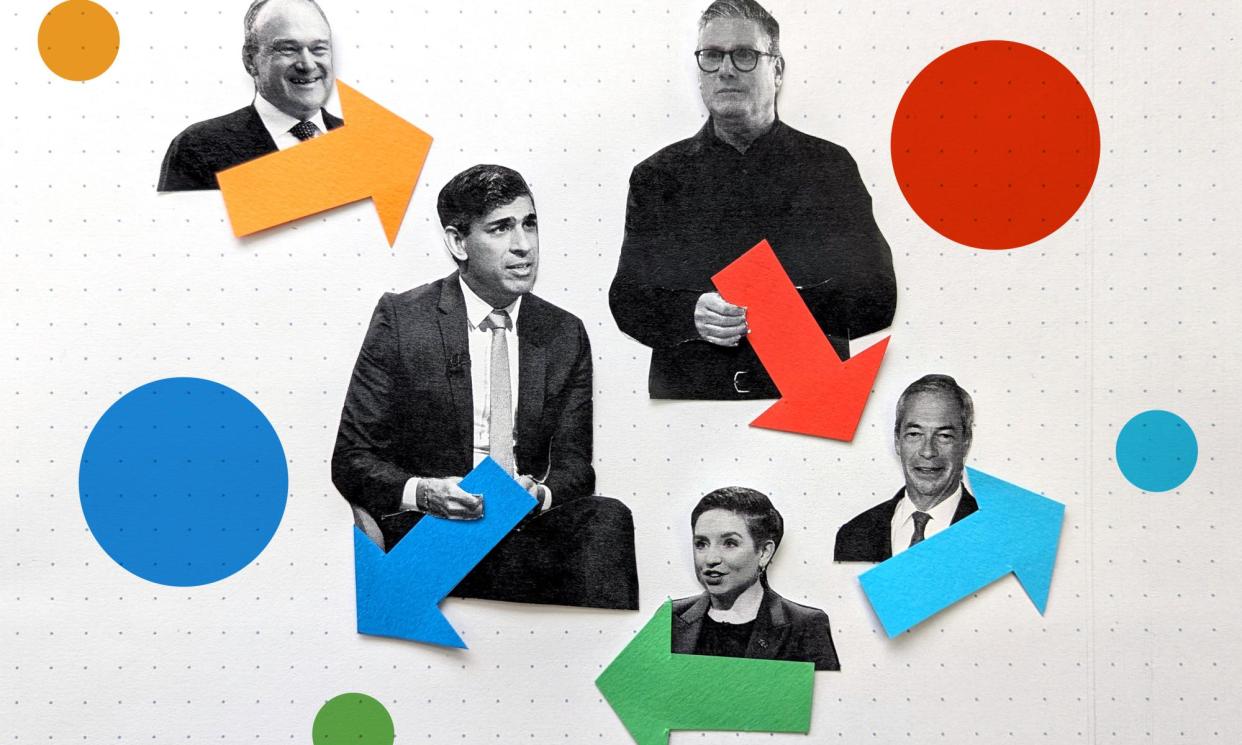When Sunak called an election, Labour was 22 points ahead. Has anything changed?

It’s been six weeks since Rishi Sunak, in his rain-sodden jacket, announced the next UK general election would be held on 4 July.
At that point, Labour was leading by 21.8 points in the polls. Now, as we come to the end of a largely stale six-week campaign, their lead stands at 20 points – down nearly two points.
Overall, Labour has fallen in the polls from 44.8% on 22 May to 40.7% on 2 July – two days before polling day.
But this has not translated into a similar drop in their overall lead because the Conservatives have also seen their support drop.
As of 1 July, the Conservatives were on 20.7% – down 2.3 points from 23% on 22 May. While Sunak will have hoped to capitalise on Labour’s fall and close the gap, a spluttering Tory campaign – with a D-day blunder and a gambling scandal – does not look to have won him any favours in the polls.
These numbers are based on the Guardian’s poll tracker, which takes an average of all polls for the preceding 10 days.
They demonstrate the main trend seen over the campaign: there has been a drop in support for the two major parties, with Reform UK and the Lib Dems being the main beneficiaries.
default
The largest shift in the polls has been for Reform UK. They started the campaign on 11.1%, but after Nigel Farage changed his mind and came back to lead the party, they had a bounce in support and ended on 15.9%.
The campaign has seen many polling companies and analysts produce models. These are often multilevel regression and poststratification (MRP) models, produced by polling a wider pool of people, to build an understanding of local voting patterns and preferences among different voter groups, and then use constituency-level demographic data to project which party will win individual seats.
Most projections have Reform winning a couple of seats, with nine of 12 projection models analysed by the Guardian projecting a victory in Clacton.
The Lib Dems have had a positive campaign too, rising from 9.7% to 11.3%. An average of the 12 models suggests that Ed Davey’s party may end up with more than 57 seats, largely due to expected tactical voting taking place in key targets, mostly in southern England.
The Greens’ national polling has barely changed, ending with an average of 5.8% saying they will vote for the party. Forecasts range from the party keeping their one seat to winning all four of their target seats, with the average being two seats.
Scotland-level polling is harder to assess, but polls indicate that about a third of people in Scotland will vote for John Swinney’s SNP. An average of the MRP models estimate that the SNP will sink to about 17 seats in Scotland, with Labour being the main beneficiary, especially in the central belt.
Some polling companies still have Labour at over 40%, but recently a couple of polling companies – including JL Partners, Savanta and YouGov – had the party dropping slightly under this level. But their lead over the Conservatives remains solid. Barring a last-minute shift in public opinion, or a large polling miss – perhaps due to the large number of people telling polls they “don’t know” who they would vote for – has led to all projections pointing to a significant Labour majority.
Analysis of 12 different election projection models – including those from YouGov, Electoral Calculus, Britain Predicts and Ipsos – shows a range from a projected Labour seat total of 406 to 516, with the average being 454 seats.
In 2017, YouGov’s 2017 MRP model was out by 16 Tory seats and eight Labour seats. In 2019, they were out by 26 Conservative seats and 28 Labour seats.
This time round, their forecast from 19 June is Labour on 420 seats and Conservatives on 101 seats.
This would mean the Conservatives sinking to their lowest seat total in over 100 years. Rishi Sunak’s Conservatives would face the prospect of losing several of their biggest names, including Jeremy Hunt, Jacob Rees-Mogg and Alex Chalk.
But polling is just a snapshot of public opinion at the time when the fieldwork was conducted – and as we take an average of the polls over the last 10 days, there can be a delay in picking up last-minute shifts. Opinion can shift in the last few days of a campaign, especially as undecided people make up their minds. Small shifts in national vote shares can ultimately lead to large swings in the total number of seats each party ends up with.

 Yahoo News
Yahoo News 
